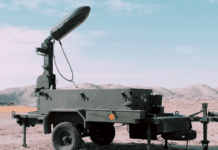This post is also available in:
 עברית (Hebrew)
עברית (Hebrew)
A development from scientists at Shanghai Jiao Tong University in China aims to redefine underwater surveillance by using seabed electromagnetic signals to extend submarine detection ranges significantly. This innovative device has reportedly been tested in the depths of the South China Sea, demonstrating the capability to detect even the quietest submarines over previously unattainable distances.
The newly developed detection technology, housed within a large pickup truck-like structure, utilizes antennas to capture extremely weak electromagnetic signals emitted by submarine propellers. Recent tests revealed that the system could identify low-frequency signals from a rotating propeller nearly 20 km away. According to Professor Jiang Weikang, this marks a considerable advancement, although he noted that while a detection range of 3 km was a significant breakthrough, the technology aims to reach over 50 km in the open sea—comparable to the range of modern torpedoes.
Historically, submarine detection using electromagnetic signals has been limited due to seawater’s tendency to weaken these signals. In order to combat this, the team took a novel approach that involves capturing signals from the seabed instead of directly from the water. As submarine propellers rotate, they generate low-frequency electromagnetic waves that penetrate the seabed and propagate through rock layers, where they weaken at a much slower rate than in seawater. This innovative technique leverages the much lower attenuation of electromagnetic waves in the seabed—just 0.173 decibels per km compared to significantly higher rates in seawater. While marine geologists have employed similar methods to locate undersea oil and gas deposits, applying this technology to submarine detection is unprecedented.
However, the research team faced challenges, particularly how weak the electromagnetic signals are when they reach the seabed and the pervasive electromagnetic noise that is not from military sources. To tackle these issues, the scientists developed an advanced algorithm capable of isolating these faint signals within a noisy environment.
Accurate target positioning is another critical obstacle, necessitating multiple high-precision sensors spread over a 1 km area, synchronized to an error margin of a billionth of a second. The team is actively working on improving the use of low-frequency electromagnetic waves for better target identification and positioning.
Equipped for long-term underwater operations, the device can also track surface ships by detecting the wake of their propellers, thereby expanding its utility beyond submarine detection.
This technological advance is particularly timely, given the growing focus on underwater warfare among major military powers. As submarines become increasingly stealthy, traditional acoustic detection systems face significant challenges. With ongoing tensions in regions like the South China Sea and the Taiwan Strait, both China and the United States are heavily investing in anti-submarine warfare capabilities.
As the race for superior underwater surveillance continues, this new detection technology could become a crucial asset in monitoring and managing maritime security. The potential to detect submarines more effectively may alter the dynamics of naval warfare, enhancing national defense strategies in an increasingly complex geopolitical landscape.

























